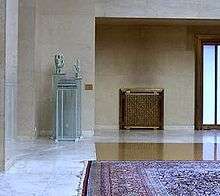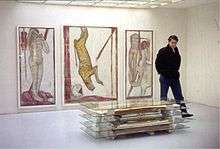Clemens Weiss



Clemens Weiss (born 1955) is a German artist living in the United States.
Youth and Education
Clemens Weiss grew up in the Region of the Lower Rhine Valley where he received technical training in mechanical engineering from 1970 to 1973. From 1977 to 1982, he studied art, philosophy, medicine and geology in Krefeld and Düsseldorf (Germany], and Vienna (Austria). Beginning in 1974, he also worked as an independent artist. In 1983 he moved to the small town of Süchteln in Germany in order to concentrate on his own philosophical and visual work. Since 1986 he has maintained a studio in Mönchengladbach in Germany (where he finished and documented his body of work) and, in 1987, moved to New York where he established his main studio and residence.
Work and Projects
Weiss, who is represented by the renowned Ronald Feldman Gallery in New York, had his first exhibition there in 1988. Since then, he has exhibited in galleries, art foundations and museums, often in conjunction with lectures and panels, and has shown many other art, theater and public sculptural projects in the United States and in Europe. Clemens Weiss has also acted as curator of large transatlantic arts and media projects, including a project for the German publication Juni (which was also published in a New York edition for the occasion), that consisted of an exhibition in Germany of specially-created print editions by New York artists in 1991.
He is engaged in international cultural exchange to oppose the large dangers threatening mankind. His sculpture Regarding Non-Proliferation of Nuclear Weapon was permanently installed in 1996 at the Palace of Nations (UN) in Geneva, as an official present from the Federal Republic of Germany to the United Nations. The sculpture consists of a group of steles with forty-two handwritten texts related to international nuclear treaties and covers the complexity of the nuclear age until 1995, the year the sculpture was finished.
Weiss investigates, and attempts by means of Installation and other groups of works, to bridge the different disciplines of art and philosophy. His installations are transparent glass constructions that often contain drawings, text, paintings, and objects[1] and he uses a similar technique in his theater productions.[2] His work is represented in prominent museums, including the Museum of Modern Art, (MOMA) in New York and the Pushkin Museum in Moscow.
Clemens Weiss lives and works in New York City.[3]

Individual exhibitions (selection)
- 2013 Galerie Kabuth, Gelsenkirchen, (Germany)
- 2012 Leibnitz University, Hanover, (Germany)
- 2011 Galleria Cortina, Milan, (Italy)
- 2011 Museum Kunst Palast, Düsseldorf (Germany)
- 2010 Redline Foundation Milwaukee, Wisconsin
- 2008 Kunstverein Herzogenrath, Germany
- 2007 Ronald Feldman Fine Arts, New York
- 2004 Galerie Bernd Lutze, Friedrichshafen (Germany)
- 2004 kunstraumno.10, Mönchengladbach (Germany)
- 2002 Kunstraum Syltquelle, Sylt
- 1998 Museum Bochum, Bochum (Germany)
- 1996 Palace of Nations, United Nations, Geneva (Switzerland)
- 1994 Galerie Seippel, Cologne (Germany)
- 1992 Neuer Aachener Kunstverein, Aachen(Germany)
- 1989 Josef-Haubrich-Kunsthalle, Cologne
- 1989 Art Cologne, Förderkoje Galerie Lohrl, Cologne (Germany)
- 1989 Anderson Gallery, Virginia Commonwealth University, Richmond (USA)
Group exhibitions (selection)
- 2013 Owens Art Gallery, Ontario, (Canada)
- 2012 Boulder Museum of Art, Boulder,Colorado
- 2009 RedLine Foundation, Denver/Colorado
- 2008 Kunst: Raum Syltquelle Rantum/Sylt (Germany)
- 2006 Suermond-Ludwig Museum, Aachen (Germany)
- 2005 Glaspalast, Heerlen, (Netherlands)
- 2004 Schick Art Gallery, Skidmore College, Saratoga Springs, NY
- 2001 Folkwang Museum, Essen. (Neuerwerbungen) (Germany)
- 2001 Museum Schloss Morsbroich, Leverkusen. (Darlings) (Germany)
- 2000 Expo 2000, Hannover. (post editionen) (Germany)
- 1999 Neue Nationalgalerie, Berlin (Das XX. Jahrhundert – 100 Jahre Kunst in Deutschland)
- 1991 Ludwig Forum für Internationale Kunst, Aachen. (Transzendenz/Transparenz)
Collections
Clemens Weiss has works in the collections of the Museum of Modern Art, Folkwang Museum (Essen), Hamburger Bahnhof (Berlin), New York Public Library (The Spencer Collection), Pushkin Museum (Moscow), Palace of Nations (Geneva), University of South Florida (Art Museum), Von der Heydt Museum (Wuppertal, Germany) and Wadsworth Atheneum, Hartford (USA).
References
- Klaus Fleming: Transparenz. Zu den Arbeiten von Clemens Weiss. In: Juni. Magazin für Kultur und Politik. Nr.2–3/89. Mönchengladbach 1989, ISSN 0931-2854
- Walter Delabar: Aus meinem Aquarium. Clemens Weiss packt die Welt in Glaskästen In: Juni. Magazin für Kultur und Politik. Nr.2–3/89. Mönchengladbach 1989
- Susanne Lingemann: Clemens Weiss – Gläserne Schreine der Erkenntnis. In: art – Das Kunstmagazin (German Wikipedia entry). Hamburg, October 1993, ISSN 0173-2781
- Franz Kotteder: 10 Welten für sich und für alle. In: Süddeutsche Zeitung vom 04/09/1997
- Clemens Weiss. In: Biographical encyclopedia of American painters, sculptors & engravers of the U.S. 2002, ISBN 0-9668526-1-3
- Ken Johnson: Clemens Weiss. In: The New York Times 11/07/2003
- Edward Leffingwell, Clemens Weiss at Ronald Feldman. In: Art in America. no. 1. (January 2008), New York, 127-128, ISSN 0004-3214
Notes
- ↑ Kunstforum international. Edition 101. 1990 ISSN 0177-3674
- ↑ G.L.A.S.S. Theater-Performance
- ↑ Armin Kaumanns: Clemes Weiss bricht sein Basislager ab. In: Rheinische Post of 8 January 2013]